(PDF) Coordination of Mathematics and Physical Resources
VerifiedAdded on 2021/02/20
|19
|4782
|249
AI Summary
Contribute Materials
Your contribution can guide someone’s learning journey. Share your
documents today.
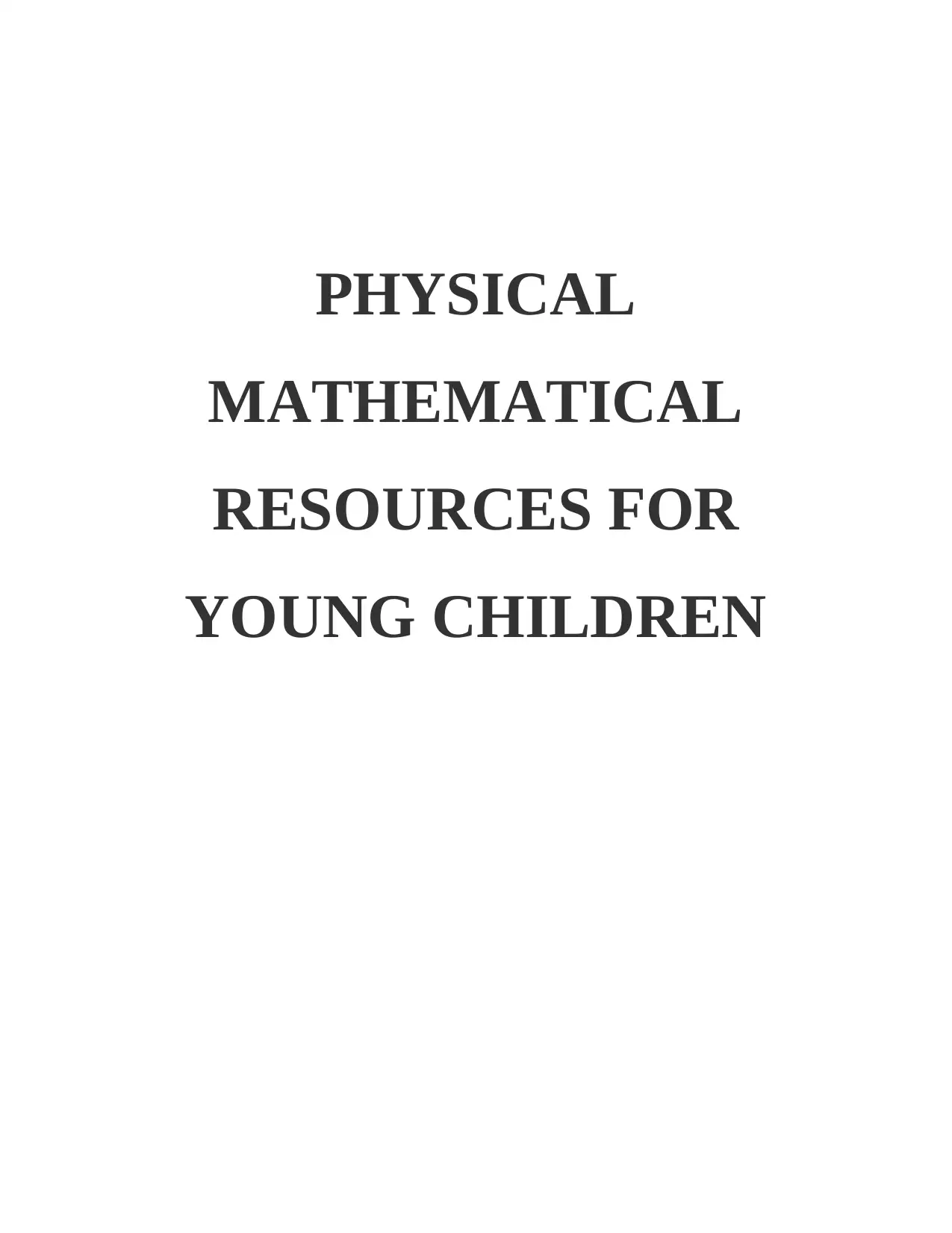
PHYSICAL
MATHEMATICAL
RESOURCES FOR
YOUNG CHILDREN
MATHEMATICAL
RESOURCES FOR
YOUNG CHILDREN
Secure Best Marks with AI Grader
Need help grading? Try our AI Grader for instant feedback on your assignments.
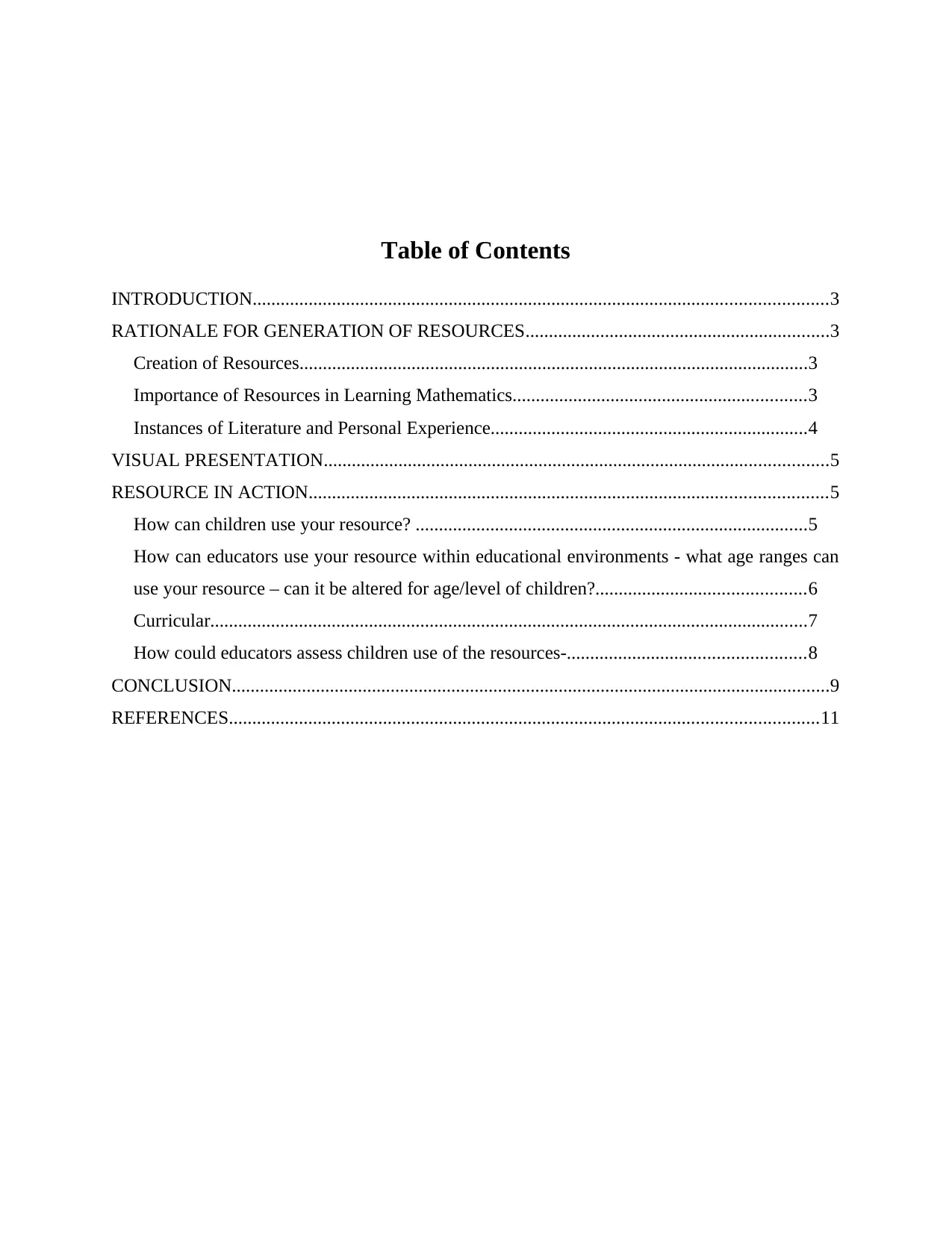
Table of Contents
INTRODUCTION...........................................................................................................................3
RATIONALE FOR GENERATION OF RESOURCES.................................................................3
Creation of Resources.............................................................................................................3
Importance of Resources in Learning Mathematics...............................................................3
Instances of Literature and Personal Experience....................................................................4
VISUAL PRESENTATION............................................................................................................5
RESOURCE IN ACTION...............................................................................................................5
How can children use your resource? ....................................................................................5
How can educators use your resource within educational environments - what age ranges can
use your resource – can it be altered for age/level of children?.............................................6
Curricular................................................................................................................................7
How could educators assess children use of the resources-...................................................8
CONCLUSION................................................................................................................................9
REFERENCES..............................................................................................................................11
INTRODUCTION...........................................................................................................................3
RATIONALE FOR GENERATION OF RESOURCES.................................................................3
Creation of Resources.............................................................................................................3
Importance of Resources in Learning Mathematics...............................................................3
Instances of Literature and Personal Experience....................................................................4
VISUAL PRESENTATION............................................................................................................5
RESOURCE IN ACTION...............................................................................................................5
How can children use your resource? ....................................................................................5
How can educators use your resource within educational environments - what age ranges can
use your resource – can it be altered for age/level of children?.............................................6
Curricular................................................................................................................................7
How could educators assess children use of the resources-...................................................8
CONCLUSION................................................................................................................................9
REFERENCES..............................................................................................................................11
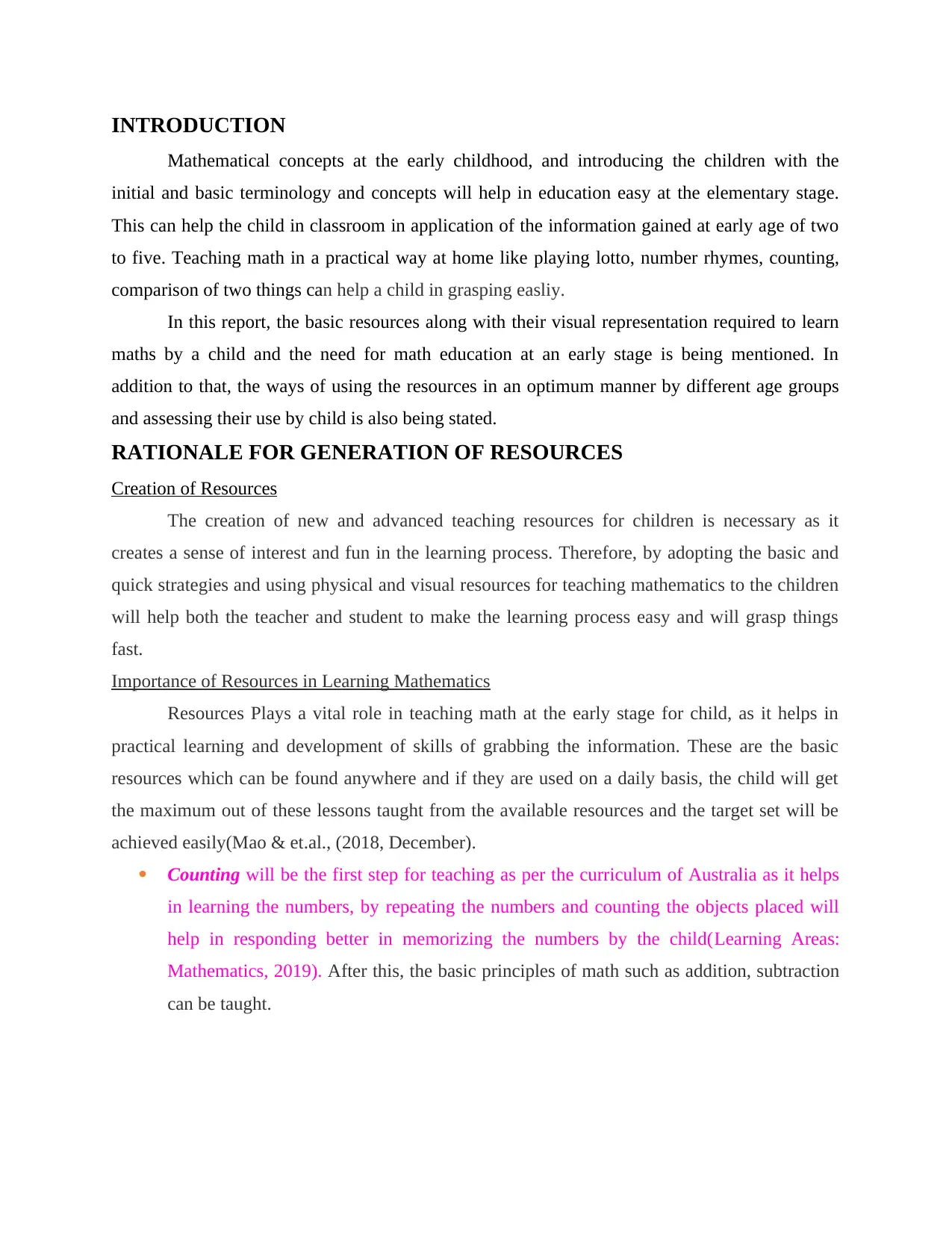
INTRODUCTION
Mathematical concepts at the early childhood, and introducing the children with the
initial and basic terminology and concepts will help in education easy at the elementary stage.
This can help the child in classroom in application of the information gained at early age of two
to five. Teaching math in a practical way at home like playing lotto, number rhymes, counting,
comparison of two things can help a child in grasping easliy.
In this report, the basic resources along with their visual representation required to learn
maths by a child and the need for math education at an early stage is being mentioned. In
addition to that, the ways of using the resources in an optimum manner by different age groups
and assessing their use by child is also being stated.
RATIONALE FOR GENERATION OF RESOURCES
Creation of Resources
The creation of new and advanced teaching resources for children is necessary as it
creates a sense of interest and fun in the learning process. Therefore, by adopting the basic and
quick strategies and using physical and visual resources for teaching mathematics to the children
will help both the teacher and student to make the learning process easy and will grasp things
fast.
Importance of Resources in Learning Mathematics
Resources Plays a vital role in teaching math at the early stage for child, as it helps in
practical learning and development of skills of grabbing the information. These are the basic
resources which can be found anywhere and if they are used on a daily basis, the child will get
the maximum out of these lessons taught from the available resources and the target set will be
achieved easily(Mao & et.al., (2018, December).
Counting will be the first step for teaching as per the curriculum of Australia as it helps
in learning the numbers, by repeating the numbers and counting the objects placed will
help in responding better in memorizing the numbers by the child(Learning Areas:
Mathematics, 2019). After this, the basic principles of math such as addition, subtraction
can be taught.
Mathematical concepts at the early childhood, and introducing the children with the
initial and basic terminology and concepts will help in education easy at the elementary stage.
This can help the child in classroom in application of the information gained at early age of two
to five. Teaching math in a practical way at home like playing lotto, number rhymes, counting,
comparison of two things can help a child in grasping easliy.
In this report, the basic resources along with their visual representation required to learn
maths by a child and the need for math education at an early stage is being mentioned. In
addition to that, the ways of using the resources in an optimum manner by different age groups
and assessing their use by child is also being stated.
RATIONALE FOR GENERATION OF RESOURCES
Creation of Resources
The creation of new and advanced teaching resources for children is necessary as it
creates a sense of interest and fun in the learning process. Therefore, by adopting the basic and
quick strategies and using physical and visual resources for teaching mathematics to the children
will help both the teacher and student to make the learning process easy and will grasp things
fast.
Importance of Resources in Learning Mathematics
Resources Plays a vital role in teaching math at the early stage for child, as it helps in
practical learning and development of skills of grabbing the information. These are the basic
resources which can be found anywhere and if they are used on a daily basis, the child will get
the maximum out of these lessons taught from the available resources and the target set will be
achieved easily(Mao & et.al., (2018, December).
Counting will be the first step for teaching as per the curriculum of Australia as it helps
in learning the numbers, by repeating the numbers and counting the objects placed will
help in responding better in memorizing the numbers by the child(Learning Areas:
Mathematics, 2019). After this, the basic principles of math such as addition, subtraction
can be taught.
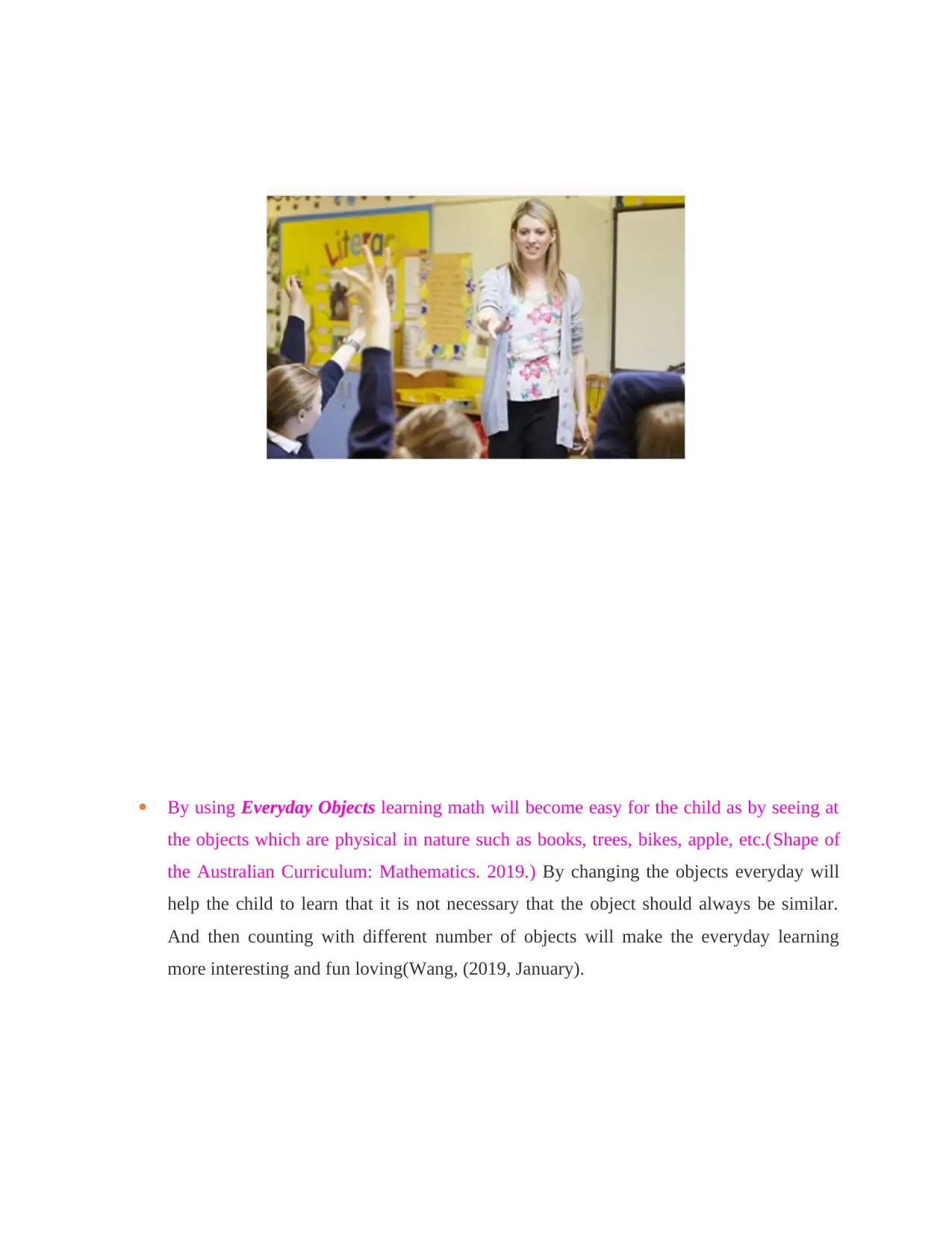
By using Everyday Objects learning math will become easy for the child as by seeing at
the objects which are physical in nature such as books, trees, bikes, apple, etc.(Shape of
the Australian Curriculum: Mathematics. 2019.) By changing the objects everyday will
help the child to learn that it is not necessary that the object should always be similar.
And then counting with different number of objects will make the everyday learning
more interesting and fun loving(Wang, (2019, January).
the objects which are physical in nature such as books, trees, bikes, apple, etc.(Shape of
the Australian Curriculum: Mathematics. 2019.) By changing the objects everyday will
help the child to learn that it is not necessary that the object should always be similar.
And then counting with different number of objects will make the everyday learning
more interesting and fun loving(Wang, (2019, January).
Secure Best Marks with AI Grader
Need help grading? Try our AI Grader for instant feedback on your assignments.
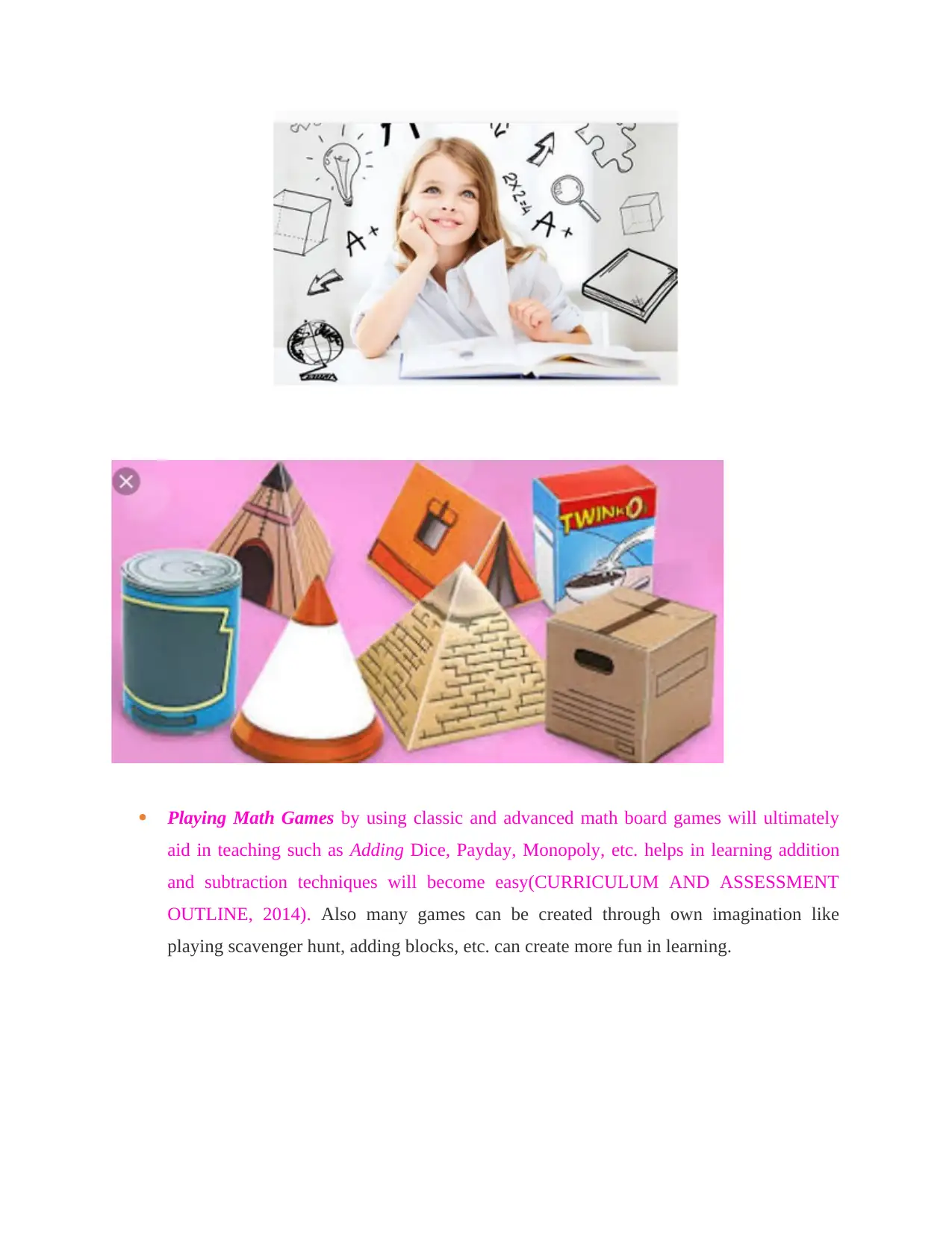
Playing Math Games by using classic and advanced math board games will ultimately
aid in teaching such as Adding Dice, Payday, Monopoly, etc. helps in learning addition
and subtraction techniques will become easy(CURRICULUM AND ASSESSMENT
OUTLINE, 2014). Also many games can be created through own imagination like
playing scavenger hunt, adding blocks, etc. can create more fun in learning.
aid in teaching such as Adding Dice, Payday, Monopoly, etc. helps in learning addition
and subtraction techniques will become easy(CURRICULUM AND ASSESSMENT
OUTLINE, 2014). Also many games can be created through own imagination like
playing scavenger hunt, adding blocks, etc. can create more fun in learning.
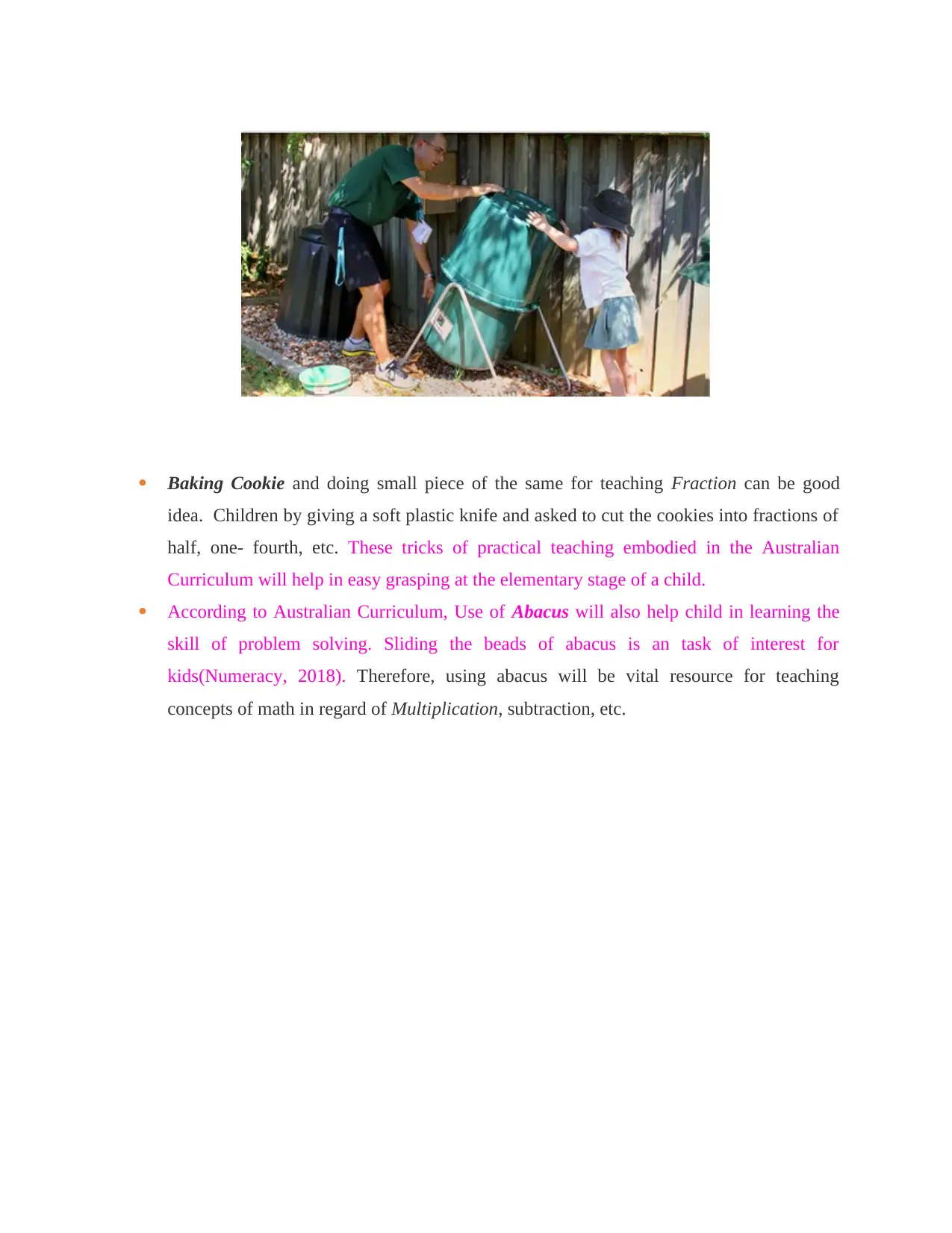
Baking Cookie and doing small piece of the same for teaching Fraction can be good
idea. Children by giving a soft plastic knife and asked to cut the cookies into fractions of
half, one- fourth, etc. These tricks of practical teaching embodied in the Australian
Curriculum will help in easy grasping at the elementary stage of a child.
According to Australian Curriculum, Use of Abacus will also help child in learning the
skill of problem solving. Sliding the beads of abacus is an task of interest for
kids(Numeracy, 2018). Therefore, using abacus will be vital resource for teaching
concepts of math in regard of Multiplication, subtraction, etc.
idea. Children by giving a soft plastic knife and asked to cut the cookies into fractions of
half, one- fourth, etc. These tricks of practical teaching embodied in the Australian
Curriculum will help in easy grasping at the elementary stage of a child.
According to Australian Curriculum, Use of Abacus will also help child in learning the
skill of problem solving. Sliding the beads of abacus is an task of interest for
kids(Numeracy, 2018). Therefore, using abacus will be vital resource for teaching
concepts of math in regard of Multiplication, subtraction, etc.
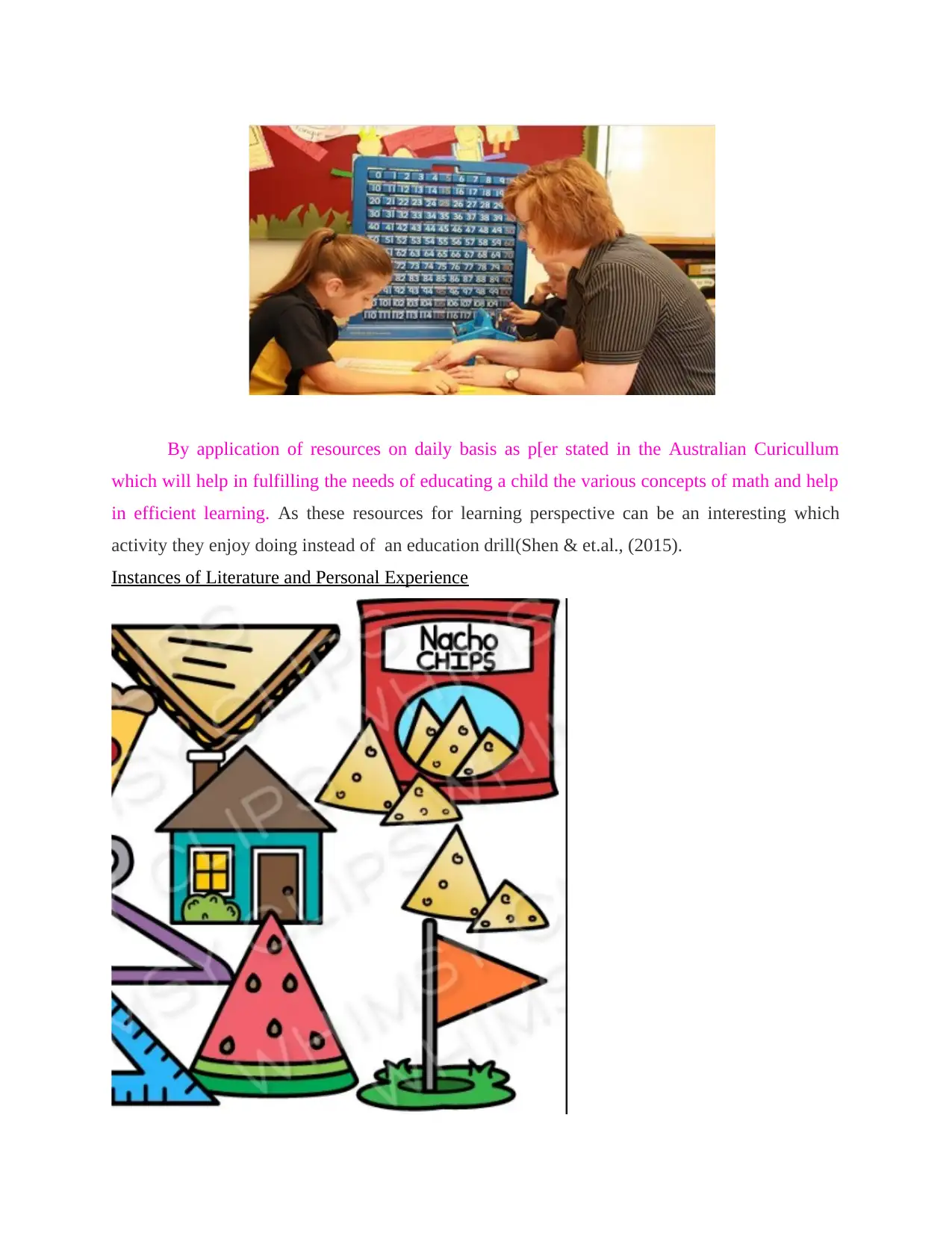
By application of resources on daily basis as p[er stated in the Australian Curicullum
which will help in fulfilling the needs of educating a child the various concepts of math and help
in efficient learning. As these resources for learning perspective can be an interesting which
activity they enjoy doing instead of an education drill(Shen & et.al., (2015).
Instances of Literature and Personal Experience
which will help in fulfilling the needs of educating a child the various concepts of math and help
in efficient learning. As these resources for learning perspective can be an interesting which
activity they enjoy doing instead of an education drill(Shen & et.al., (2015).
Instances of Literature and Personal Experience
Paraphrase This Document
Need a fresh take? Get an instant paraphrase of this document with our AI Paraphraser
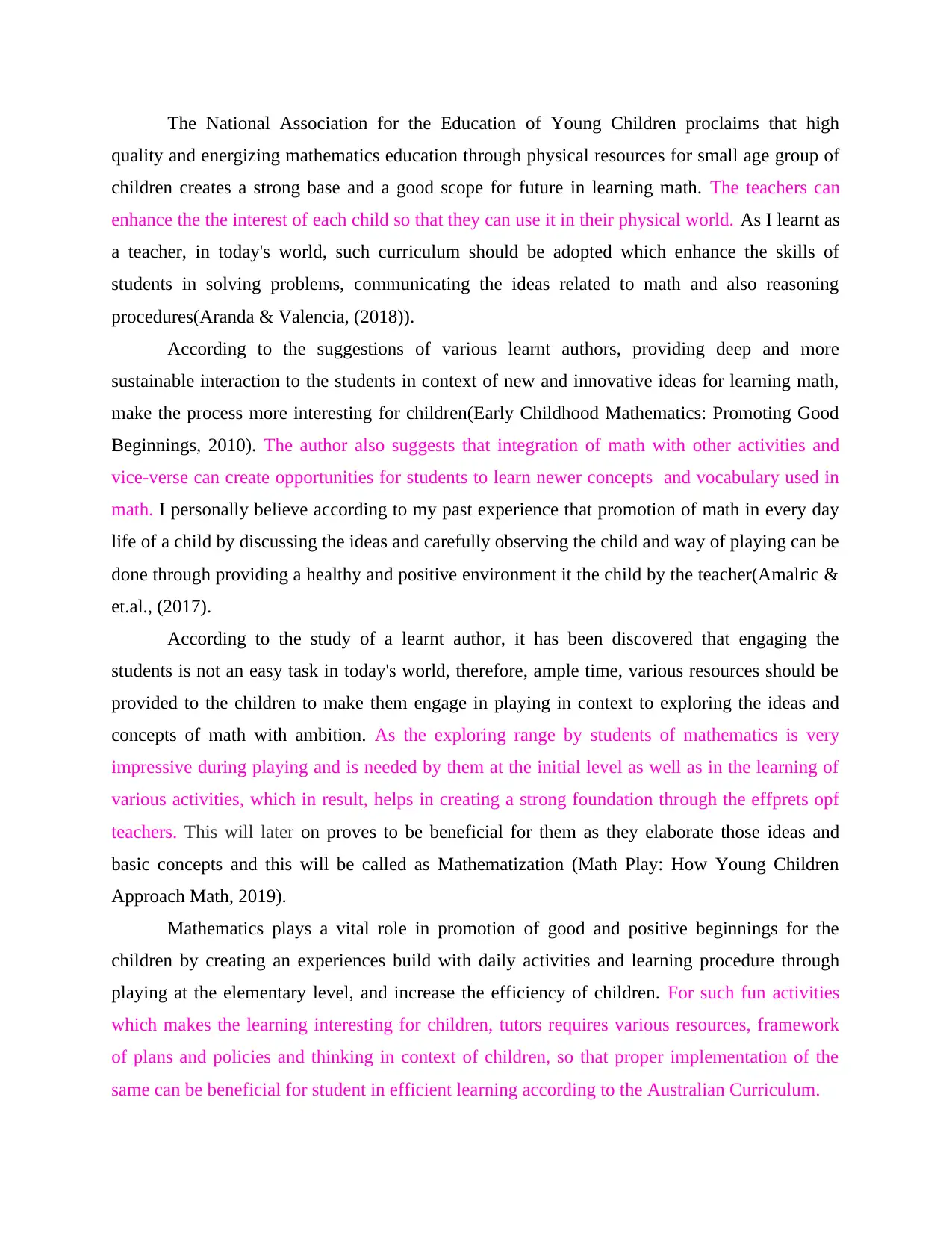
The National Association for the Education of Young Children proclaims that high
quality and energizing mathematics education through physical resources for small age group of
children creates a strong base and a good scope for future in learning math. The teachers can
enhance the the interest of each child so that they can use it in their physical world. As I learnt as
a teacher, in today's world, such curriculum should be adopted which enhance the skills of
students in solving problems, communicating the ideas related to math and also reasoning
procedures(Aranda & Valencia, (2018)).
According to the suggestions of various learnt authors, providing deep and more
sustainable interaction to the students in context of new and innovative ideas for learning math,
make the process more interesting for children(Early Childhood Mathematics: Promoting Good
Beginnings, 2010). The author also suggests that integration of math with other activities and
vice-verse can create opportunities for students to learn newer concepts and vocabulary used in
math. I personally believe according to my past experience that promotion of math in every day
life of a child by discussing the ideas and carefully observing the child and way of playing can be
done through providing a healthy and positive environment it the child by the teacher(Amalric &
et.al., (2017).
According to the study of a learnt author, it has been discovered that engaging the
students is not an easy task in today's world, therefore, ample time, various resources should be
provided to the children to make them engage in playing in context to exploring the ideas and
concepts of math with ambition. As the exploring range by students of mathematics is very
impressive during playing and is needed by them at the initial level as well as in the learning of
various activities, which in result, helps in creating a strong foundation through the effprets opf
teachers. This will later on proves to be beneficial for them as they elaborate those ideas and
basic concepts and this will be called as Mathematization (Math Play: How Young Children
Approach Math, 2019).
Mathematics plays a vital role in promotion of good and positive beginnings for the
children by creating an experiences build with daily activities and learning procedure through
playing at the elementary level, and increase the efficiency of children. For such fun activities
which makes the learning interesting for children, tutors requires various resources, framework
of plans and policies and thinking in context of children, so that proper implementation of the
same can be beneficial for student in efficient learning according to the Australian Curriculum.
quality and energizing mathematics education through physical resources for small age group of
children creates a strong base and a good scope for future in learning math. The teachers can
enhance the the interest of each child so that they can use it in their physical world. As I learnt as
a teacher, in today's world, such curriculum should be adopted which enhance the skills of
students in solving problems, communicating the ideas related to math and also reasoning
procedures(Aranda & Valencia, (2018)).
According to the suggestions of various learnt authors, providing deep and more
sustainable interaction to the students in context of new and innovative ideas for learning math,
make the process more interesting for children(Early Childhood Mathematics: Promoting Good
Beginnings, 2010). The author also suggests that integration of math with other activities and
vice-verse can create opportunities for students to learn newer concepts and vocabulary used in
math. I personally believe according to my past experience that promotion of math in every day
life of a child by discussing the ideas and carefully observing the child and way of playing can be
done through providing a healthy and positive environment it the child by the teacher(Amalric &
et.al., (2017).
According to the study of a learnt author, it has been discovered that engaging the
students is not an easy task in today's world, therefore, ample time, various resources should be
provided to the children to make them engage in playing in context to exploring the ideas and
concepts of math with ambition. As the exploring range by students of mathematics is very
impressive during playing and is needed by them at the initial level as well as in the learning of
various activities, which in result, helps in creating a strong foundation through the effprets opf
teachers. This will later on proves to be beneficial for them as they elaborate those ideas and
basic concepts and this will be called as Mathematization (Math Play: How Young Children
Approach Math, 2019).
Mathematics plays a vital role in promotion of good and positive beginnings for the
children by creating an experiences build with daily activities and learning procedure through
playing at the elementary level, and increase the efficiency of children. For such fun activities
which makes the learning interesting for children, tutors requires various resources, framework
of plans and policies and thinking in context of children, so that proper implementation of the
same can be beneficial for student in efficient learning according to the Australian Curriculum.
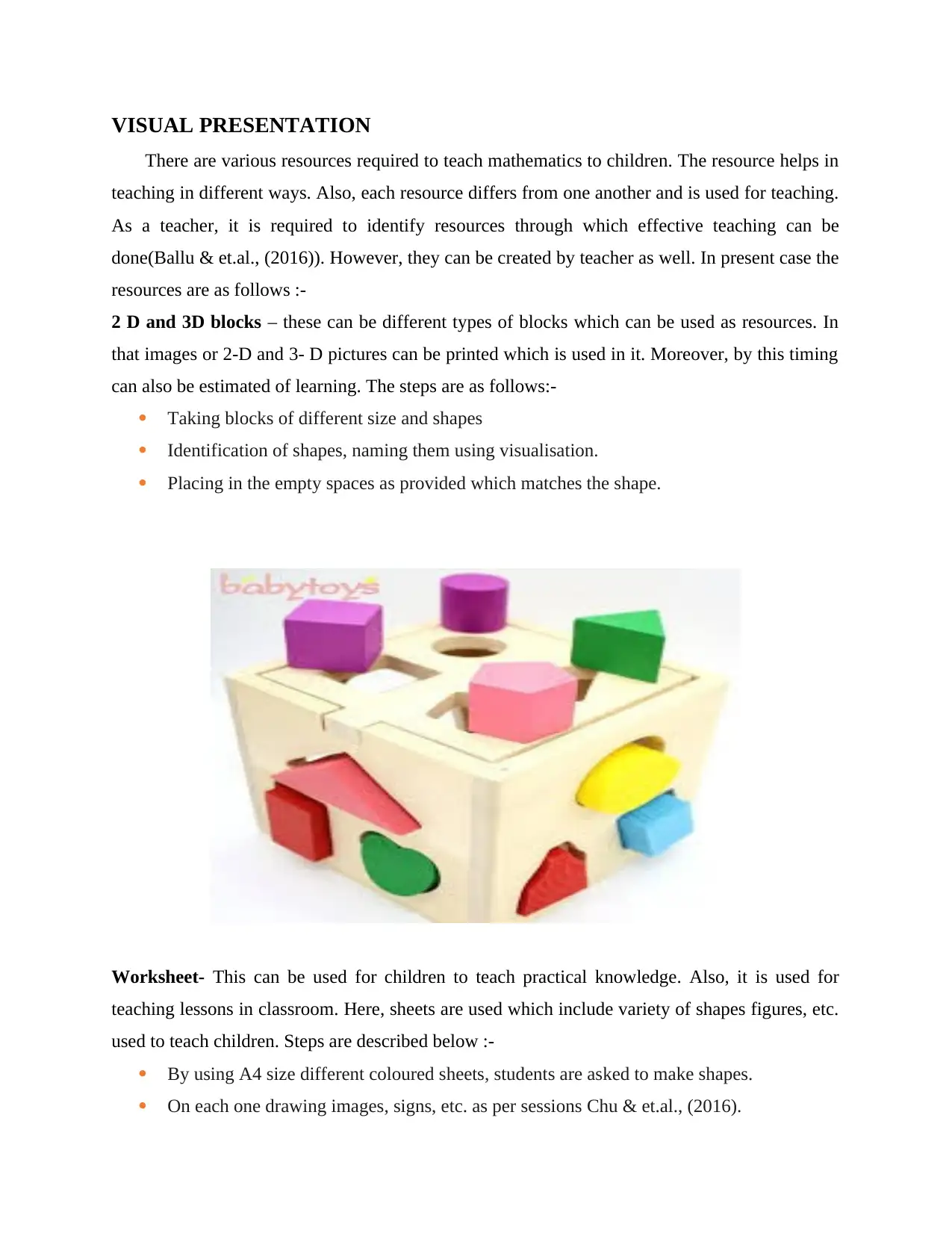
VISUAL PRESENTATION
There are various resources required to teach mathematics to children. The resource helps in
teaching in different ways. Also, each resource differs from one another and is used for teaching.
As a teacher, it is required to identify resources through which effective teaching can be
done(Ballu & et.al., (2016)). However, they can be created by teacher as well. In present case the
resources are as follows :-
2 D and 3D blocks – these can be different types of blocks which can be used as resources. In
that images or 2-D and 3- D pictures can be printed which is used in it. Moreover, by this timing
can also be estimated of learning. The steps are as follows:-
Taking blocks of different size and shapes
Identification of shapes, naming them using visualisation.
Placing in the empty spaces as provided which matches the shape.
Worksheet- This can be used for children to teach practical knowledge. Also, it is used for
teaching lessons in classroom. Here, sheets are used which include variety of shapes figures, etc.
used to teach children. Steps are described below :-
By using A4 size different coloured sheets, students are asked to make shapes.
On each one drawing images, signs, etc. as per sessions Chu & et.al., (2016).
There are various resources required to teach mathematics to children. The resource helps in
teaching in different ways. Also, each resource differs from one another and is used for teaching.
As a teacher, it is required to identify resources through which effective teaching can be
done(Ballu & et.al., (2016)). However, they can be created by teacher as well. In present case the
resources are as follows :-
2 D and 3D blocks – these can be different types of blocks which can be used as resources. In
that images or 2-D and 3- D pictures can be printed which is used in it. Moreover, by this timing
can also be estimated of learning. The steps are as follows:-
Taking blocks of different size and shapes
Identification of shapes, naming them using visualisation.
Placing in the empty spaces as provided which matches the shape.
Worksheet- This can be used for children to teach practical knowledge. Also, it is used for
teaching lessons in classroom. Here, sheets are used which include variety of shapes figures, etc.
used to teach children. Steps are described below :-
By using A4 size different coloured sheets, students are asked to make shapes.
On each one drawing images, signs, etc. as per sessions Chu & et.al., (2016).
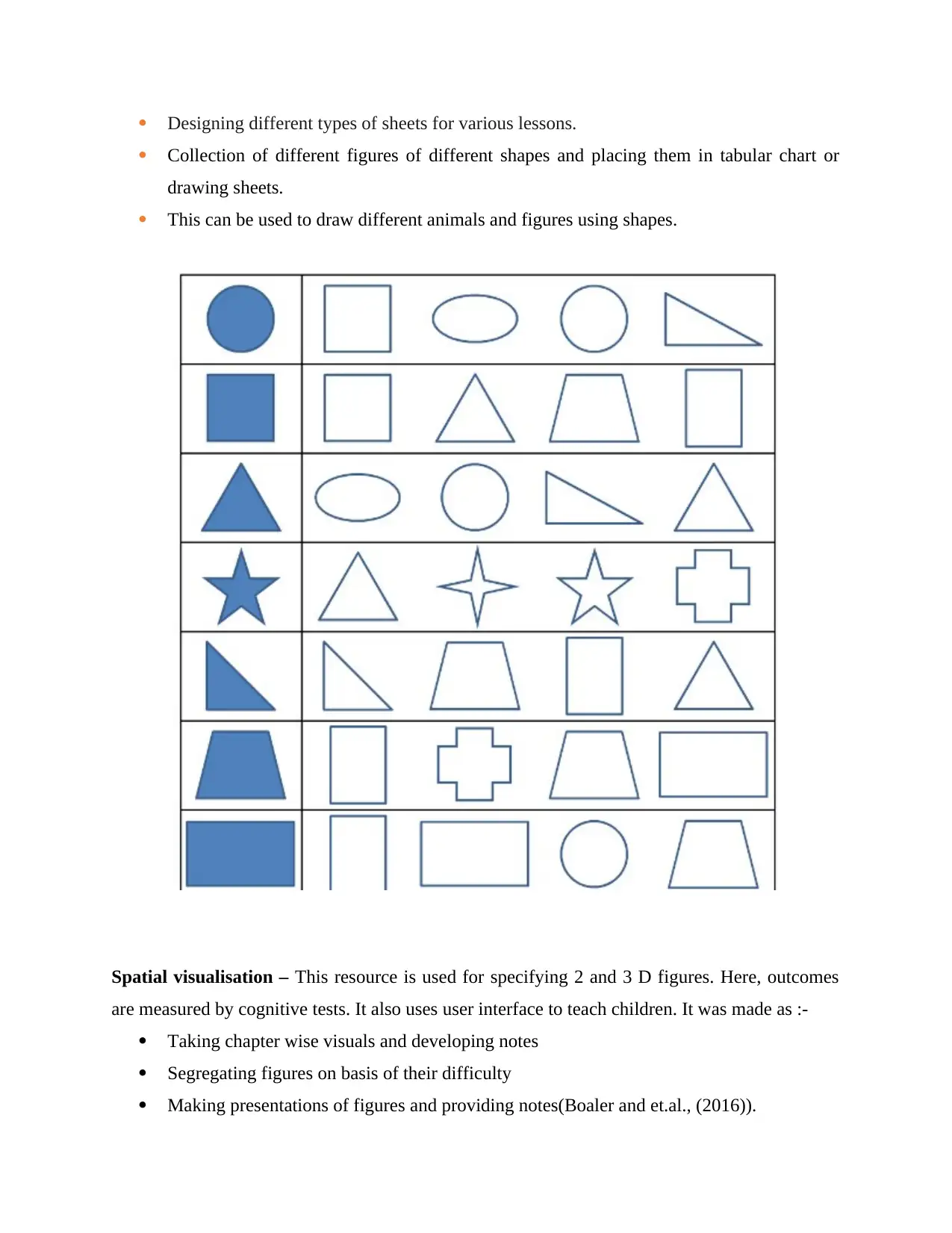
Designing different types of sheets for various lessons.
Collection of different figures of different shapes and placing them in tabular chart or
drawing sheets.
This can be used to draw different animals and figures using shapes.
Spatial visualisation – This resource is used for specifying 2 and 3 D figures. Here, outcomes
are measured by cognitive tests. It also uses user interface to teach children. It was made as :-
Taking chapter wise visuals and developing notes
Segregating figures on basis of their difficulty
Making presentations of figures and providing notes(Boaler and et.al., (2016)).
Collection of different figures of different shapes and placing them in tabular chart or
drawing sheets.
This can be used to draw different animals and figures using shapes.
Spatial visualisation – This resource is used for specifying 2 and 3 D figures. Here, outcomes
are measured by cognitive tests. It also uses user interface to teach children. It was made as :-
Taking chapter wise visuals and developing notes
Segregating figures on basis of their difficulty
Making presentations of figures and providing notes(Boaler and et.al., (2016)).
Secure Best Marks with AI Grader
Need help grading? Try our AI Grader for instant feedback on your assignments.
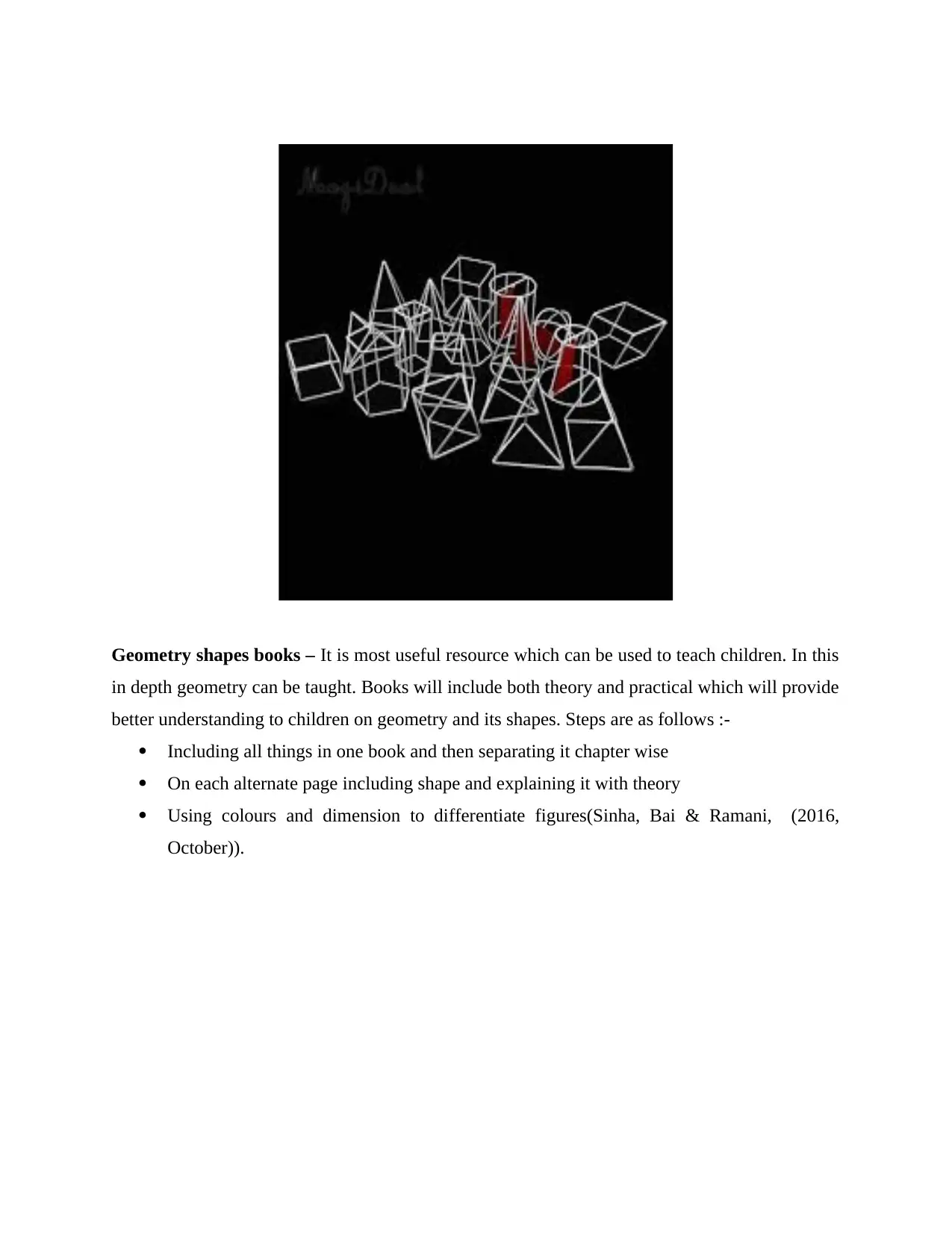
Geometry shapes books – It is most useful resource which can be used to teach children. In this
in depth geometry can be taught. Books will include both theory and practical which will provide
better understanding to children on geometry and its shapes. Steps are as follows :-
Including all things in one book and then separating it chapter wise
On each alternate page including shape and explaining it with theory
Using colours and dimension to differentiate figures(Sinha, Bai & Ramani, (2016,
October)).
in depth geometry can be taught. Books will include both theory and practical which will provide
better understanding to children on geometry and its shapes. Steps are as follows :-
Including all things in one book and then separating it chapter wise
On each alternate page including shape and explaining it with theory
Using colours and dimension to differentiate figures(Sinha, Bai & Ramani, (2016,
October)).

So, these all physical resources will be used to teach geometry to children. It will enable
teacher to use it according to their needs. Furthermore, visual presentation makes it easy to teach
mathematics and clear understanding of figures(Gao, Brodzki & Mukherjee, (2016)).
RESOURCE IN ACTION
Recourse which are used in the study are the shapes and objects which are used by students in
generating the deep learning skills in the students which can provide them an easy learning skills
which are used to evaluate the mathematical learnings and increase the thinking skills, use of
mathematical games which are used for students to frame the learning skills and help the students
in effective learning, baking cookie can help the students to learn shapes which are required to
increase learning skills, abacus helps in the learning of mathematics.
How can children use your resource?
Classroom practice:
Teacher can teach a specific task like geometry shapes and figures which can help them in
learning and developing. Geometry can help students to develop their personal skills which will
help in all round development of the organization which will help students to grow socially and
individually. Children will use these resources by a proper learning methods like analysing the
objects and using their skills and knowledge by relating to the objects of the outer world, relating
teacher to use it according to their needs. Furthermore, visual presentation makes it easy to teach
mathematics and clear understanding of figures(Gao, Brodzki & Mukherjee, (2016)).
RESOURCE IN ACTION
Recourse which are used in the study are the shapes and objects which are used by students in
generating the deep learning skills in the students which can provide them an easy learning skills
which are used to evaluate the mathematical learnings and increase the thinking skills, use of
mathematical games which are used for students to frame the learning skills and help the students
in effective learning, baking cookie can help the students to learn shapes which are required to
increase learning skills, abacus helps in the learning of mathematics.
How can children use your resource?
Classroom practice:
Teacher can teach a specific task like geometry shapes and figures which can help them in
learning and developing. Geometry can help students to develop their personal skills which will
help in all round development of the organization which will help students to grow socially and
individually. Children will use these resources by a proper learning methods like analysing the
objects and using their skills and knowledge by relating to the objects of the outer world, relating
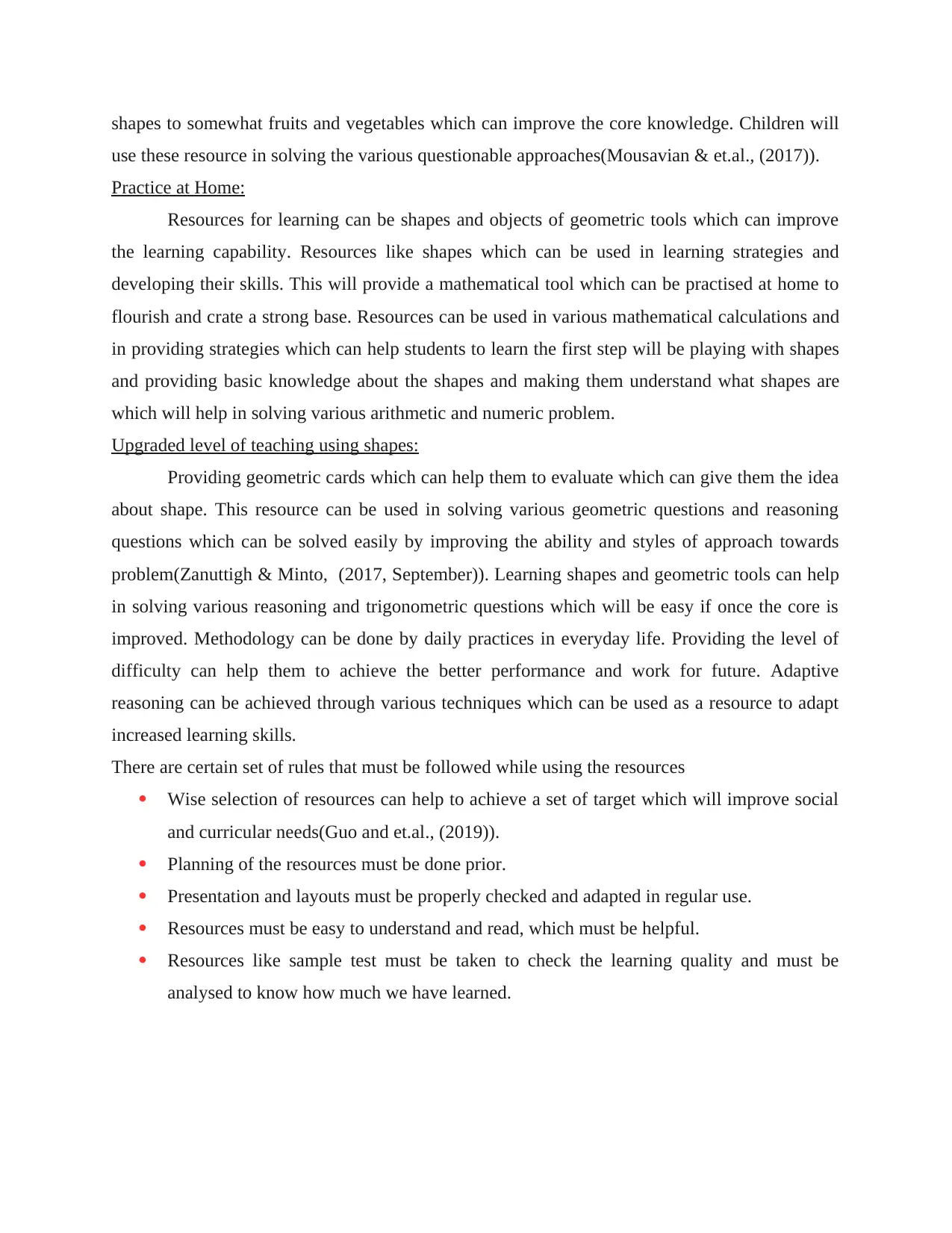
shapes to somewhat fruits and vegetables which can improve the core knowledge. Children will
use these resource in solving the various questionable approaches(Mousavian & et.al., (2017)).
Practice at Home:
Resources for learning can be shapes and objects of geometric tools which can improve
the learning capability. Resources like shapes which can be used in learning strategies and
developing their skills. This will provide a mathematical tool which can be practised at home to
flourish and crate a strong base. Resources can be used in various mathematical calculations and
in providing strategies which can help students to learn the first step will be playing with shapes
and providing basic knowledge about the shapes and making them understand what shapes are
which will help in solving various arithmetic and numeric problem.
Upgraded level of teaching using shapes:
Providing geometric cards which can help them to evaluate which can give them the idea
about shape. This resource can be used in solving various geometric questions and reasoning
questions which can be solved easily by improving the ability and styles of approach towards
problem(Zanuttigh & Minto, (2017, September)). Learning shapes and geometric tools can help
in solving various reasoning and trigonometric questions which will be easy if once the core is
improved. Methodology can be done by daily practices in everyday life. Providing the level of
difficulty can help them to achieve the better performance and work for future. Adaptive
reasoning can be achieved through various techniques which can be used as a resource to adapt
increased learning skills.
There are certain set of rules that must be followed while using the resources
Wise selection of resources can help to achieve a set of target which will improve social
and curricular needs(Guo and et.al., (2019)).
Planning of the resources must be done prior.
Presentation and layouts must be properly checked and adapted in regular use.
Resources must be easy to understand and read, which must be helpful.
Resources like sample test must be taken to check the learning quality and must be
analysed to know how much we have learned.
use these resource in solving the various questionable approaches(Mousavian & et.al., (2017)).
Practice at Home:
Resources for learning can be shapes and objects of geometric tools which can improve
the learning capability. Resources like shapes which can be used in learning strategies and
developing their skills. This will provide a mathematical tool which can be practised at home to
flourish and crate a strong base. Resources can be used in various mathematical calculations and
in providing strategies which can help students to learn the first step will be playing with shapes
and providing basic knowledge about the shapes and making them understand what shapes are
which will help in solving various arithmetic and numeric problem.
Upgraded level of teaching using shapes:
Providing geometric cards which can help them to evaluate which can give them the idea
about shape. This resource can be used in solving various geometric questions and reasoning
questions which can be solved easily by improving the ability and styles of approach towards
problem(Zanuttigh & Minto, (2017, September)). Learning shapes and geometric tools can help
in solving various reasoning and trigonometric questions which will be easy if once the core is
improved. Methodology can be done by daily practices in everyday life. Providing the level of
difficulty can help them to achieve the better performance and work for future. Adaptive
reasoning can be achieved through various techniques which can be used as a resource to adapt
increased learning skills.
There are certain set of rules that must be followed while using the resources
Wise selection of resources can help to achieve a set of target which will improve social
and curricular needs(Guo and et.al., (2019)).
Planning of the resources must be done prior.
Presentation and layouts must be properly checked and adapted in regular use.
Resources must be easy to understand and read, which must be helpful.
Resources like sample test must be taken to check the learning quality and must be
analysed to know how much we have learned.
Paraphrase This Document
Need a fresh take? Get an instant paraphrase of this document with our AI Paraphraser
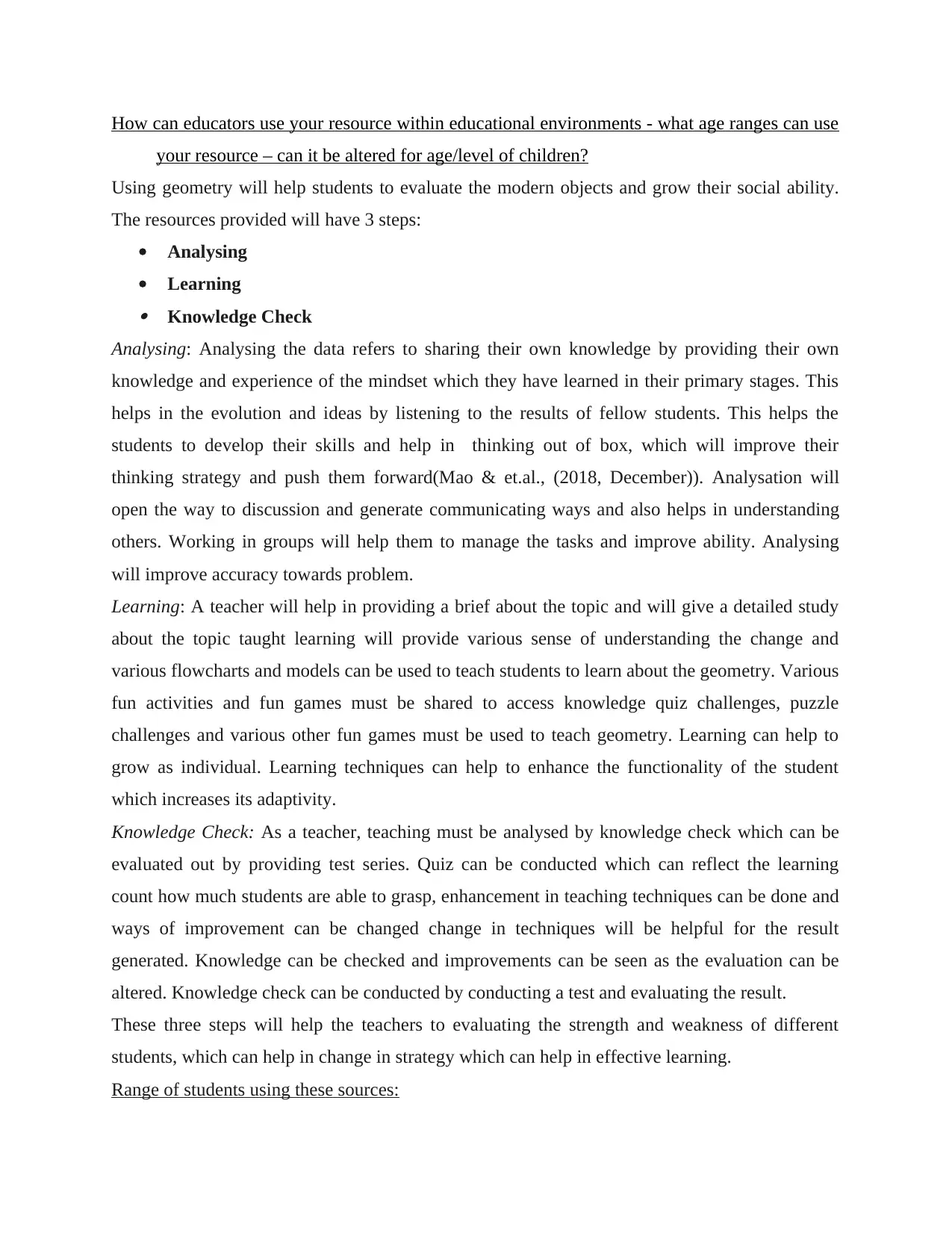
How can educators use your resource within educational environments - what age ranges can use
your resource – can it be altered for age/level of children?
Using geometry will help students to evaluate the modern objects and grow their social ability.
The resources provided will have 3 steps:
Analysing
Learning Knowledge Check
Analysing: Analysing the data refers to sharing their own knowledge by providing their own
knowledge and experience of the mindset which they have learned in their primary stages. This
helps in the evolution and ideas by listening to the results of fellow students. This helps the
students to develop their skills and help in thinking out of box, which will improve their
thinking strategy and push them forward(Mao & et.al., (2018, December)). Analysation will
open the way to discussion and generate communicating ways and also helps in understanding
others. Working in groups will help them to manage the tasks and improve ability. Analysing
will improve accuracy towards problem.
Learning: A teacher will help in providing a brief about the topic and will give a detailed study
about the topic taught learning will provide various sense of understanding the change and
various flowcharts and models can be used to teach students to learn about the geometry. Various
fun activities and fun games must be shared to access knowledge quiz challenges, puzzle
challenges and various other fun games must be used to teach geometry. Learning can help to
grow as individual. Learning techniques can help to enhance the functionality of the student
which increases its adaptivity.
Knowledge Check: As a teacher, teaching must be analysed by knowledge check which can be
evaluated out by providing test series. Quiz can be conducted which can reflect the learning
count how much students are able to grasp, enhancement in teaching techniques can be done and
ways of improvement can be changed change in techniques will be helpful for the result
generated. Knowledge can be checked and improvements can be seen as the evaluation can be
altered. Knowledge check can be conducted by conducting a test and evaluating the result.
These three steps will help the teachers to evaluating the strength and weakness of different
students, which can help in change in strategy which can help in effective learning.
Range of students using these sources:
your resource – can it be altered for age/level of children?
Using geometry will help students to evaluate the modern objects and grow their social ability.
The resources provided will have 3 steps:
Analysing
Learning Knowledge Check
Analysing: Analysing the data refers to sharing their own knowledge by providing their own
knowledge and experience of the mindset which they have learned in their primary stages. This
helps in the evolution and ideas by listening to the results of fellow students. This helps the
students to develop their skills and help in thinking out of box, which will improve their
thinking strategy and push them forward(Mao & et.al., (2018, December)). Analysation will
open the way to discussion and generate communicating ways and also helps in understanding
others. Working in groups will help them to manage the tasks and improve ability. Analysing
will improve accuracy towards problem.
Learning: A teacher will help in providing a brief about the topic and will give a detailed study
about the topic taught learning will provide various sense of understanding the change and
various flowcharts and models can be used to teach students to learn about the geometry. Various
fun activities and fun games must be shared to access knowledge quiz challenges, puzzle
challenges and various other fun games must be used to teach geometry. Learning can help to
grow as individual. Learning techniques can help to enhance the functionality of the student
which increases its adaptivity.
Knowledge Check: As a teacher, teaching must be analysed by knowledge check which can be
evaluated out by providing test series. Quiz can be conducted which can reflect the learning
count how much students are able to grasp, enhancement in teaching techniques can be done and
ways of improvement can be changed change in techniques will be helpful for the result
generated. Knowledge can be checked and improvements can be seen as the evaluation can be
altered. Knowledge check can be conducted by conducting a test and evaluating the result.
These three steps will help the teachers to evaluating the strength and weakness of different
students, which can help in change in strategy which can help in effective learning.
Range of students using these sources:

This can be used for classes I to V which can be helpful for them in the geometrical
works. Use of shapes and learning shapes can help in evaluating the ability in the competitive
exams, use of geometry can be helpful in increasing the reasoning ability which can improve the
performance. Geometrical tools and studies helps in increased reasoning knowledge. Geometric
tools can be used in many aspects of life like for higher educating it can help in understanding
many software like CAD, CAM etc. which are used for designing various structures and figures.
This is effective tool for the students which can help the students with physical and mental
growth.
Curriculum:
Curriculum includes basic learning procedures which are undertaken for teaching techniques.
For foundation years group bright coloured block must be used to make students aware of
the block shapes and sizes, this can be done by fun activities like asking for colour and shape
combination which will help them to recognise well. This will take 6 classroom sessions.
Students are made to recognise and classify two dimensional shapes and three dimensional
objectives using figures which are mentioned above(ACMMG009). This will also include
counting of similar shapes.
Second stage will provide them with typical shapes and figures increasing the thinking
ability of the students. This task will take at-least four sessions to complete the task. Recognising
2-d and 3-d shapes using various features, focusing on features of geometry and objects using
everyday words like edges, corners, vertices etc.(ACMMG022). moreover clay art using shapes
and structures can be used in teaching methodology.
Third stage will provide them with different dimension of shapes which will give them a
brief idea about the shapes and their structure. This will require 5 classroom sessions. As detailed
learning is provided use of technology and without the use of technology. It includes drawing of
shapes and labelling shapes and sizes(ACMMG042). Identifying key features of shapes like
rectangle square kite rohmbus etc.
Fourth stage will explain about the angles induces and the sub of angles, various
properties associated with the shapes(ACMMG087). Comparing areas of shapes and irregular
shapes by formal means like counting number of blocks, area required of given figure, no of tiles
used etc.
works. Use of shapes and learning shapes can help in evaluating the ability in the competitive
exams, use of geometry can be helpful in increasing the reasoning ability which can improve the
performance. Geometrical tools and studies helps in increased reasoning knowledge. Geometric
tools can be used in many aspects of life like for higher educating it can help in understanding
many software like CAD, CAM etc. which are used for designing various structures and figures.
This is effective tool for the students which can help the students with physical and mental
growth.
Curriculum:
Curriculum includes basic learning procedures which are undertaken for teaching techniques.
For foundation years group bright coloured block must be used to make students aware of
the block shapes and sizes, this can be done by fun activities like asking for colour and shape
combination which will help them to recognise well. This will take 6 classroom sessions.
Students are made to recognise and classify two dimensional shapes and three dimensional
objectives using figures which are mentioned above(ACMMG009). This will also include
counting of similar shapes.
Second stage will provide them with typical shapes and figures increasing the thinking
ability of the students. This task will take at-least four sessions to complete the task. Recognising
2-d and 3-d shapes using various features, focusing on features of geometry and objects using
everyday words like edges, corners, vertices etc.(ACMMG022). moreover clay art using shapes
and structures can be used in teaching methodology.
Third stage will provide them with different dimension of shapes which will give them a
brief idea about the shapes and their structure. This will require 5 classroom sessions. As detailed
learning is provided use of technology and without the use of technology. It includes drawing of
shapes and labelling shapes and sizes(ACMMG042). Identifying key features of shapes like
rectangle square kite rohmbus etc.
Fourth stage will explain about the angles induces and the sub of angles, various
properties associated with the shapes(ACMMG087). Comparing areas of shapes and irregular
shapes by formal means like counting number of blocks, area required of given figure, no of tiles
used etc.
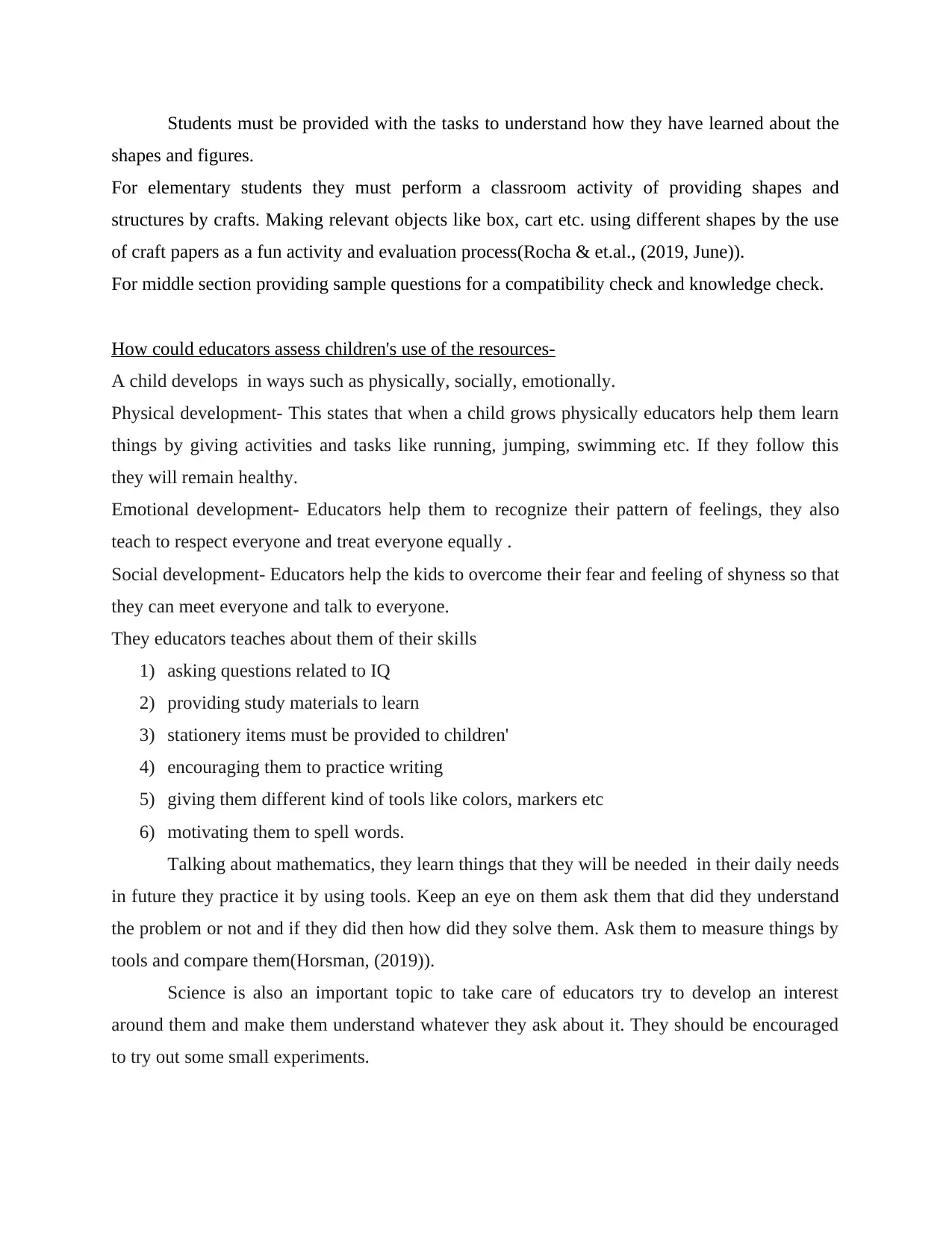
Students must be provided with the tasks to understand how they have learned about the
shapes and figures.
For elementary students they must perform a classroom activity of providing shapes and
structures by crafts. Making relevant objects like box, cart etc. using different shapes by the use
of craft papers as a fun activity and evaluation process(Rocha & et.al., (2019, June)).
For middle section providing sample questions for a compatibility check and knowledge check.
How could educators assess children's use of the resources-
A child develops in ways such as physically, socially, emotionally.
Physical development- This states that when a child grows physically educators help them learn
things by giving activities and tasks like running, jumping, swimming etc. If they follow this
they will remain healthy.
Emotional development- Educators help them to recognize their pattern of feelings, they also
teach to respect everyone and treat everyone equally .
Social development- Educators help the kids to overcome their fear and feeling of shyness so that
they can meet everyone and talk to everyone.
They educators teaches about them of their skills
1) asking questions related to IQ
2) providing study materials to learn
3) stationery items must be provided to children'
4) encouraging them to practice writing
5) giving them different kind of tools like colors, markers etc
6) motivating them to spell words.
Talking about mathematics, they learn things that they will be needed in their daily needs
in future they practice it by using tools. Keep an eye on them ask them that did they understand
the problem or not and if they did then how did they solve them. Ask them to measure things by
tools and compare them(Horsman, (2019)).
Science is also an important topic to take care of educators try to develop an interest
around them and make them understand whatever they ask about it. They should be encouraged
to try out some small experiments.
shapes and figures.
For elementary students they must perform a classroom activity of providing shapes and
structures by crafts. Making relevant objects like box, cart etc. using different shapes by the use
of craft papers as a fun activity and evaluation process(Rocha & et.al., (2019, June)).
For middle section providing sample questions for a compatibility check and knowledge check.
How could educators assess children's use of the resources-
A child develops in ways such as physically, socially, emotionally.
Physical development- This states that when a child grows physically educators help them learn
things by giving activities and tasks like running, jumping, swimming etc. If they follow this
they will remain healthy.
Emotional development- Educators help them to recognize their pattern of feelings, they also
teach to respect everyone and treat everyone equally .
Social development- Educators help the kids to overcome their fear and feeling of shyness so that
they can meet everyone and talk to everyone.
They educators teaches about them of their skills
1) asking questions related to IQ
2) providing study materials to learn
3) stationery items must be provided to children'
4) encouraging them to practice writing
5) giving them different kind of tools like colors, markers etc
6) motivating them to spell words.
Talking about mathematics, they learn things that they will be needed in their daily needs
in future they practice it by using tools. Keep an eye on them ask them that did they understand
the problem or not and if they did then how did they solve them. Ask them to measure things by
tools and compare them(Horsman, (2019)).
Science is also an important topic to take care of educators try to develop an interest
around them and make them understand whatever they ask about it. They should be encouraged
to try out some small experiments.
Secure Best Marks with AI Grader
Need help grading? Try our AI Grader for instant feedback on your assignments.
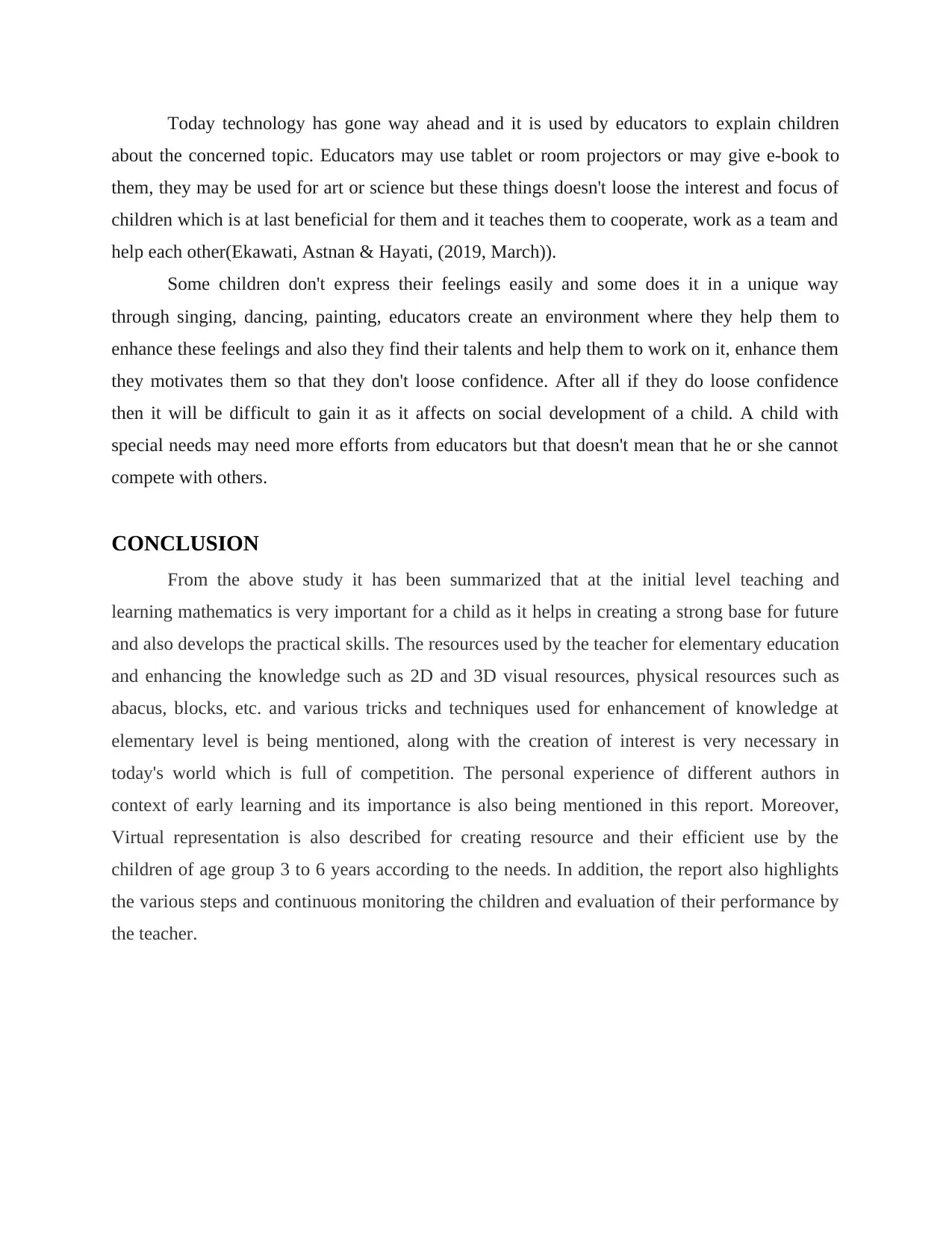
Today technology has gone way ahead and it is used by educators to explain children
about the concerned topic. Educators may use tablet or room projectors or may give e-book to
them, they may be used for art or science but these things doesn't loose the interest and focus of
children which is at last beneficial for them and it teaches them to cooperate, work as a team and
help each other(Ekawati, Astnan & Hayati, (2019, March)).
Some children don't express their feelings easily and some does it in a unique way
through singing, dancing, painting, educators create an environment where they help them to
enhance these feelings and also they find their talents and help them to work on it, enhance them
they motivates them so that they don't loose confidence. After all if they do loose confidence
then it will be difficult to gain it as it affects on social development of a child. A child with
special needs may need more efforts from educators but that doesn't mean that he or she cannot
compete with others.
CONCLUSION
From the above study it has been summarized that at the initial level teaching and
learning mathematics is very important for a child as it helps in creating a strong base for future
and also develops the practical skills. The resources used by the teacher for elementary education
and enhancing the knowledge such as 2D and 3D visual resources, physical resources such as
abacus, blocks, etc. and various tricks and techniques used for enhancement of knowledge at
elementary level is being mentioned, along with the creation of interest is very necessary in
today's world which is full of competition. The personal experience of different authors in
context of early learning and its importance is also being mentioned in this report. Moreover,
Virtual representation is also described for creating resource and their efficient use by the
children of age group 3 to 6 years according to the needs. In addition, the report also highlights
the various steps and continuous monitoring the children and evaluation of their performance by
the teacher.
about the concerned topic. Educators may use tablet or room projectors or may give e-book to
them, they may be used for art or science but these things doesn't loose the interest and focus of
children which is at last beneficial for them and it teaches them to cooperate, work as a team and
help each other(Ekawati, Astnan & Hayati, (2019, March)).
Some children don't express their feelings easily and some does it in a unique way
through singing, dancing, painting, educators create an environment where they help them to
enhance these feelings and also they find their talents and help them to work on it, enhance them
they motivates them so that they don't loose confidence. After all if they do loose confidence
then it will be difficult to gain it as it affects on social development of a child. A child with
special needs may need more efforts from educators but that doesn't mean that he or she cannot
compete with others.
CONCLUSION
From the above study it has been summarized that at the initial level teaching and
learning mathematics is very important for a child as it helps in creating a strong base for future
and also develops the practical skills. The resources used by the teacher for elementary education
and enhancing the knowledge such as 2D and 3D visual resources, physical resources such as
abacus, blocks, etc. and various tricks and techniques used for enhancement of knowledge at
elementary level is being mentioned, along with the creation of interest is very necessary in
today's world which is full of competition. The personal experience of different authors in
context of early learning and its importance is also being mentioned in this report. Moreover,
Virtual representation is also described for creating resource and their efficient use by the
children of age group 3 to 6 years according to the needs. In addition, the report also highlights
the various steps and continuous monitoring the children and evaluation of their performance by
the teacher.
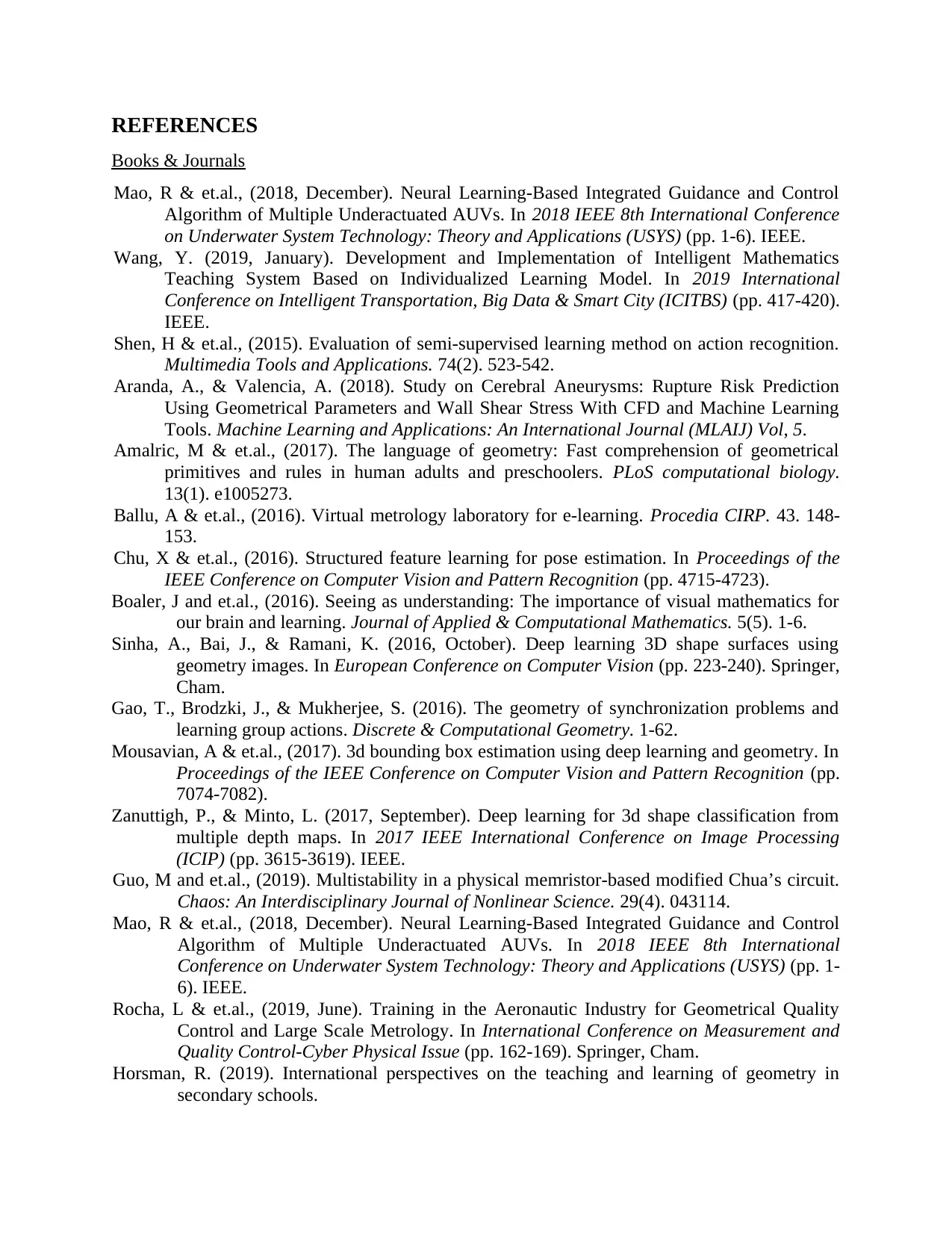
REFERENCES
Books & Journals
Mao, R & et.al., (2018, December). Neural Learning-Based Integrated Guidance and Control
Algorithm of Multiple Underactuated AUVs. In 2018 IEEE 8th International Conference
on Underwater System Technology: Theory and Applications (USYS) (pp. 1-6). IEEE.
Wang, Y. (2019, January). Development and Implementation of Intelligent Mathematics
Teaching System Based on Individualized Learning Model. In 2019 International
Conference on Intelligent Transportation, Big Data & Smart City (ICITBS) (pp. 417-420).
IEEE.
Shen, H & et.al., (2015). Evaluation of semi-supervised learning method on action recognition.
Multimedia Tools and Applications. 74(2). 523-542.
Aranda, A., & Valencia, A. (2018). Study on Cerebral Aneurysms: Rupture Risk Prediction
Using Geometrical Parameters and Wall Shear Stress With CFD and Machine Learning
Tools. Machine Learning and Applications: An International Journal (MLAIJ) Vol, 5.
Amalric, M & et.al., (2017). The language of geometry: Fast comprehension of geometrical
primitives and rules in human adults and preschoolers. PLoS computational biology.
13(1). e1005273.
Ballu, A & et.al., (2016). Virtual metrology laboratory for e-learning. Procedia CIRP. 43. 148-
153.
Chu, X & et.al., (2016). Structured feature learning for pose estimation. In Proceedings of the
IEEE Conference on Computer Vision and Pattern Recognition (pp. 4715-4723).
Boaler, J and et.al., (2016). Seeing as understanding: The importance of visual mathematics for
our brain and learning. Journal of Applied & Computational Mathematics. 5(5). 1-6.
Sinha, A., Bai, J., & Ramani, K. (2016, October). Deep learning 3D shape surfaces using
geometry images. In European Conference on Computer Vision (pp. 223-240). Springer,
Cham.
Gao, T., Brodzki, J., & Mukherjee, S. (2016). The geometry of synchronization problems and
learning group actions. Discrete & Computational Geometry. 1-62.
Mousavian, A & et.al., (2017). 3d bounding box estimation using deep learning and geometry. In
Proceedings of the IEEE Conference on Computer Vision and Pattern Recognition (pp.
7074-7082).
Zanuttigh, P., & Minto, L. (2017, September). Deep learning for 3d shape classification from
multiple depth maps. In 2017 IEEE International Conference on Image Processing
(ICIP) (pp. 3615-3619). IEEE.
Guo, M and et.al., (2019). Multistability in a physical memristor-based modified Chua’s circuit.
Chaos: An Interdisciplinary Journal of Nonlinear Science. 29(4). 043114.
Mao, R & et.al., (2018, December). Neural Learning-Based Integrated Guidance and Control
Algorithm of Multiple Underactuated AUVs. In 2018 IEEE 8th International
Conference on Underwater System Technology: Theory and Applications (USYS) (pp. 1-
6). IEEE.
Rocha, L & et.al., (2019, June). Training in the Aeronautic Industry for Geometrical Quality
Control and Large Scale Metrology. In International Conference on Measurement and
Quality Control-Cyber Physical Issue (pp. 162-169). Springer, Cham.
Horsman, R. (2019). International perspectives on the teaching and learning of geometry in
secondary schools.
Books & Journals
Mao, R & et.al., (2018, December). Neural Learning-Based Integrated Guidance and Control
Algorithm of Multiple Underactuated AUVs. In 2018 IEEE 8th International Conference
on Underwater System Technology: Theory and Applications (USYS) (pp. 1-6). IEEE.
Wang, Y. (2019, January). Development and Implementation of Intelligent Mathematics
Teaching System Based on Individualized Learning Model. In 2019 International
Conference on Intelligent Transportation, Big Data & Smart City (ICITBS) (pp. 417-420).
IEEE.
Shen, H & et.al., (2015). Evaluation of semi-supervised learning method on action recognition.
Multimedia Tools and Applications. 74(2). 523-542.
Aranda, A., & Valencia, A. (2018). Study on Cerebral Aneurysms: Rupture Risk Prediction
Using Geometrical Parameters and Wall Shear Stress With CFD and Machine Learning
Tools. Machine Learning and Applications: An International Journal (MLAIJ) Vol, 5.
Amalric, M & et.al., (2017). The language of geometry: Fast comprehension of geometrical
primitives and rules in human adults and preschoolers. PLoS computational biology.
13(1). e1005273.
Ballu, A & et.al., (2016). Virtual metrology laboratory for e-learning. Procedia CIRP. 43. 148-
153.
Chu, X & et.al., (2016). Structured feature learning for pose estimation. In Proceedings of the
IEEE Conference on Computer Vision and Pattern Recognition (pp. 4715-4723).
Boaler, J and et.al., (2016). Seeing as understanding: The importance of visual mathematics for
our brain and learning. Journal of Applied & Computational Mathematics. 5(5). 1-6.
Sinha, A., Bai, J., & Ramani, K. (2016, October). Deep learning 3D shape surfaces using
geometry images. In European Conference on Computer Vision (pp. 223-240). Springer,
Cham.
Gao, T., Brodzki, J., & Mukherjee, S. (2016). The geometry of synchronization problems and
learning group actions. Discrete & Computational Geometry. 1-62.
Mousavian, A & et.al., (2017). 3d bounding box estimation using deep learning and geometry. In
Proceedings of the IEEE Conference on Computer Vision and Pattern Recognition (pp.
7074-7082).
Zanuttigh, P., & Minto, L. (2017, September). Deep learning for 3d shape classification from
multiple depth maps. In 2017 IEEE International Conference on Image Processing
(ICIP) (pp. 3615-3619). IEEE.
Guo, M and et.al., (2019). Multistability in a physical memristor-based modified Chua’s circuit.
Chaos: An Interdisciplinary Journal of Nonlinear Science. 29(4). 043114.
Mao, R & et.al., (2018, December). Neural Learning-Based Integrated Guidance and Control
Algorithm of Multiple Underactuated AUVs. In 2018 IEEE 8th International
Conference on Underwater System Technology: Theory and Applications (USYS) (pp. 1-
6). IEEE.
Rocha, L & et.al., (2019, June). Training in the Aeronautic Industry for Geometrical Quality
Control and Large Scale Metrology. In International Conference on Measurement and
Quality Control-Cyber Physical Issue (pp. 162-169). Springer, Cham.
Horsman, R. (2019). International perspectives on the teaching and learning of geometry in
secondary schools.
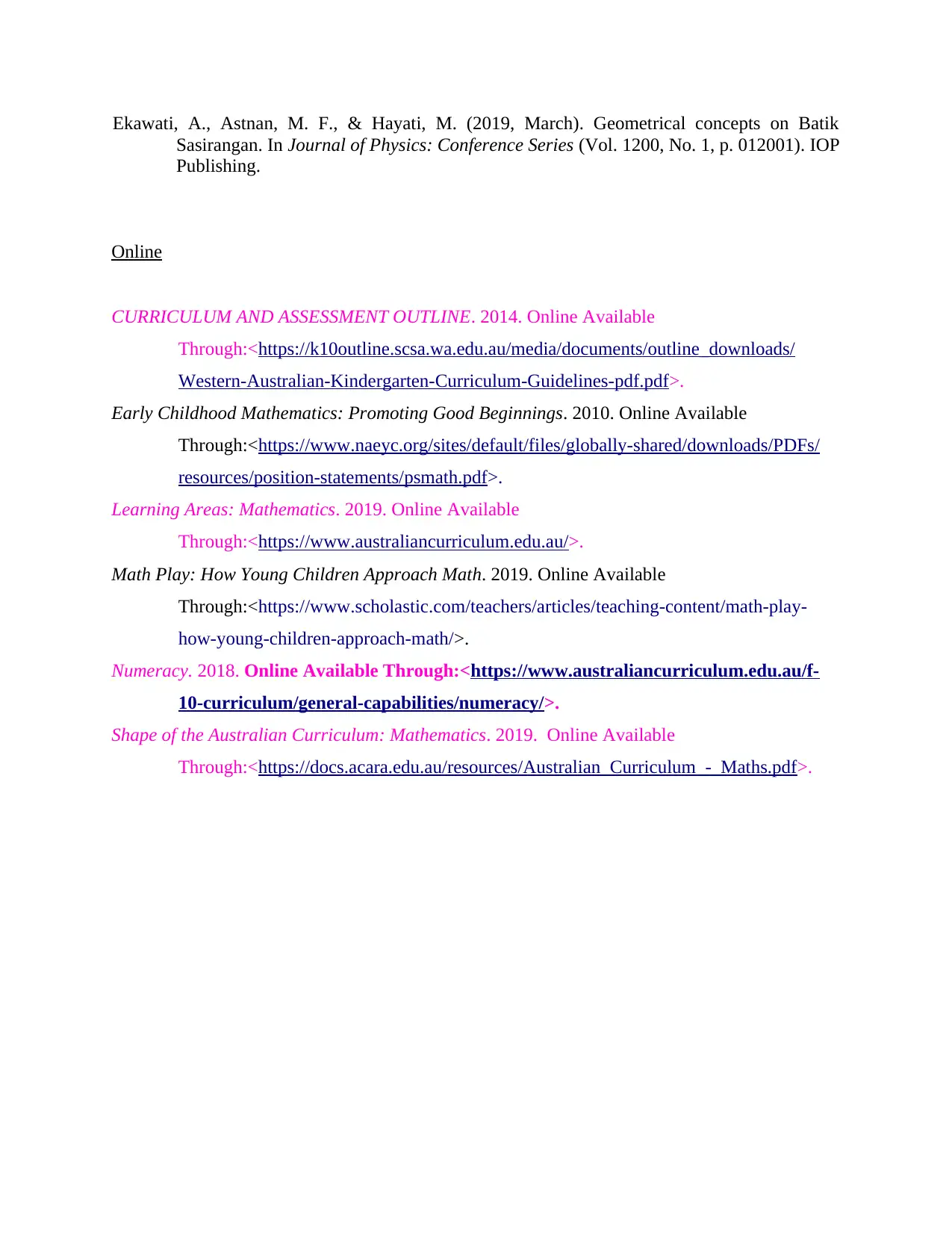
Ekawati, A., Astnan, M. F., & Hayati, M. (2019, March). Geometrical concepts on Batik
Sasirangan. In Journal of Physics: Conference Series (Vol. 1200, No. 1, p. 012001). IOP
Publishing.
Online
CURRICULUM AND ASSESSMENT OUTLINE. 2014. Online Available
Through:<https://k10outline.scsa.wa.edu.au/media/documents/outline_downloads/
Western-Australian-Kindergarten-Curriculum-Guidelines-pdf.pdf>.
Early Childhood Mathematics: Promoting Good Beginnings. 2010. Online Available
Through:<https://www.naeyc.org/sites/default/files/globally-shared/downloads/PDFs/
resources/position-statements/psmath.pdf>.
Learning Areas: Mathematics. 2019. Online Available
Through:<https://www.australiancurriculum.edu.au/>.
Math Play: How Young Children Approach Math. 2019. Online Available
Through:<https://www.scholastic.com/teachers/articles/teaching-content/math-play-
how-young-children-approach-math/>.
Numeracy. 2018. Online Available Through:<https://www.australiancurriculum.edu.au/f-
10-curriculum/general-capabilities/numeracy/>.
Shape of the Australian Curriculum: Mathematics. 2019. Online Available
Through:<https://docs.acara.edu.au/resources/Australian_Curriculum_-_Maths.pdf>.
Sasirangan. In Journal of Physics: Conference Series (Vol. 1200, No. 1, p. 012001). IOP
Publishing.
Online
CURRICULUM AND ASSESSMENT OUTLINE. 2014. Online Available
Through:<https://k10outline.scsa.wa.edu.au/media/documents/outline_downloads/
Western-Australian-Kindergarten-Curriculum-Guidelines-pdf.pdf>.
Early Childhood Mathematics: Promoting Good Beginnings. 2010. Online Available
Through:<https://www.naeyc.org/sites/default/files/globally-shared/downloads/PDFs/
resources/position-statements/psmath.pdf>.
Learning Areas: Mathematics. 2019. Online Available
Through:<https://www.australiancurriculum.edu.au/>.
Math Play: How Young Children Approach Math. 2019. Online Available
Through:<https://www.scholastic.com/teachers/articles/teaching-content/math-play-
how-young-children-approach-math/>.
Numeracy. 2018. Online Available Through:<https://www.australiancurriculum.edu.au/f-
10-curriculum/general-capabilities/numeracy/>.
Shape of the Australian Curriculum: Mathematics. 2019. Online Available
Through:<https://docs.acara.edu.au/resources/Australian_Curriculum_-_Maths.pdf>.
1 out of 19
Related Documents
Your All-in-One AI-Powered Toolkit for Academic Success.
+13062052269
info@desklib.com
Available 24*7 on WhatsApp / Email
![[object Object]](/_next/static/media/star-bottom.7253800d.svg)
Unlock your academic potential
© 2024 | Zucol Services PVT LTD | All rights reserved.




